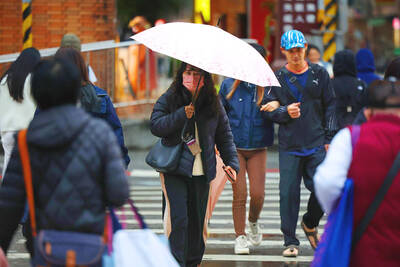The Taipei Mass Rapid Transit (MRT) has operated at a loss every year since it opened in 1996, but could balance its books with an average fare hike of just NT$0.5 (US$0.02), a Taipei Rapid Transit Corp representative said.
The Taipei MRT has failed to generate a profit, despite increasing passenger numbers, Taipei Rapid Transit Corp planning division director Wu Chun-yo (吳俊佑) said.
“That branch of the corporation loses money every year, it is just a matter of by how much,” he said.
In bad years the MRT runs up a deficit of between NT$700 million and NT$800 million, he said.
However, the company last year posted a NT$300 million deficit, the lowest in its history, because it took steps to boost passenger numbers on weekends, Wu said.
“We rolled out single-day passes for families and groups, and deals were struck with Taipei 101 and businesses in the Yongkang Road (永康) area to give gifts to tourists using the single-day pass,” Wu said. “Those measures have increased ridership and therefore fare revenue.”
“After [Taipei] Mayor Ko Wen-je (柯文哲) took office, he demanded that the operational efficiency of the MRT be maximized to offset losses in transit operations,” he said.
The MRT last year branched out its business operations, including initiatives to rent office space at its stations, Wu said.
Rent from office space generated revenue of NT$68 million and rent from online vendor Catch Power Co’s merchandize retrieval boxes — located in 108 MRT stations — generated another NT$15 million, he said.
The expansion of commercial space in MRT stations was followed by an increase in the number of visitors, resulting in greater opportunities for paid advertisement, Wu said.
Business operations peripheral to urban transit has more than made up for the deficit that transit operations have incurred, with the company’s bottom line having risen from NT$500 million in 2015 to NT$1.5 billion last year, he said.
“When the then-Muzha (木柵) Line opened in 1996 it was the MRT’s only service and it had a daily ridership of 30,000 people. Now the urban transit network has a daily ridership of 2.03 million,” Wu said.
“The chronic deficit in the transit arm is caused by the need to set aside funds every year in anticipation of buying new carriages,” he said.
“The Taipei MRT services also differ significantly from those in New Taipei City in terms of profitability, with most of the revenue-generating lines in Taipei passing through places where businesses sustain traffic,” he said.
In contrast, New Taipei City lines tend to make less money or operate at a loss, such as the Blue Line section that goes to Tucheng District (土城), Wu said.
Total ridership in the Taipei MRT was 730 million last year, Wu said, adding that a small increase in minimum fares — from NT$23 to a hypothetical NT$23.5 — would be sufficient for the transit arm to turn a profit.
However, the Taipei City Government has no plans to hike ticket prices in the short term due to policy concerns, Wu said.

SHIPS, TRAINS AND AUTOMOBILES: The ministry has announced changes to varied transportation industries taking effect soon, with a number of effects for passengers Beginning next month, the post office is canceling signature upon delivery and written inquiry services for international registered small packets in accordance with the new policy of the Universal Postal Union, the Ministry of Transportation and Communications said yesterday. The new policy does not apply to packets that are to be delivered to China, the ministry said. Senders of international registered small packets would receive a NT$10 rebate on postage if the packets are sent from Jan. 1 to March 31, it added. The ministry said that three other policies are also scheduled to take effect next month. International cruise ship operators

NUMBERS IMBALANCE: More than 4 million Taiwanese have visited China this year, while only about half a million Chinese have visited here Beijing has yet to respond to Taiwan’s requests for negotiation over matters related to the recovery of cross-strait tourism, the Tourism Administration said yesterday. Taiwan’s tourism authority issued the statement after Chinese-language daily the China Times reported yesterday that the government’s policy of banning group tours to China does not stop Taiwanese from visiting the country. As of October, more than 4.2 million had traveled to China this year, exceeding last year. Beijing estimated the number of Taiwanese tourists in China could reach 4.5 million this year. By contrast, only 500,000 Chinese tourists are expected in Taiwan, the report said. The report

Temperatures are forecast to drop steadily as a continental cold air mass moves across Taiwan, with some areas also likely to see heavy rainfall, the Central Weather Administration (CWA) said. From today through early tomorrow, a cold air mass would keep temperatures low across central and northern Taiwan, and the eastern half of Taiwan proper, with isolated brief showers forecast along Keelung’s north coast, Taipei and New Taipei City’s mountainous areas and eastern Taiwan, it said. Lows of 11°C to 15°C are forecast in central and northern Taiwan, Yilan County, and the outlying Kinmen and Lienchiang (Matsu) counties, and 14°C to 17°C

STEERING FAILURE: The first boat of its class is experiencing teething issues as it readies for acceptance by the navy, according to a recent story about rudder failure The Hai Kun (海鯤), the nation’s first locally built submarine, allegedly suffered a total failure of stern hydraulic systems during the second round of sea acceptance trials on June 26, and sailors were forced to manually operate the X-rudder to turn the submarine and return to port, news Web site Mirror Daily reported yesterday. The report said that tugboats following the Hai Kun assisted the submarine in avoiding collisions with other ships due to the X-rudder malfunctioning. At the time of the report, the submarine had completed its trials and was scheduled to begin diving and surfacing tests in shallow areas. The X-rudder,